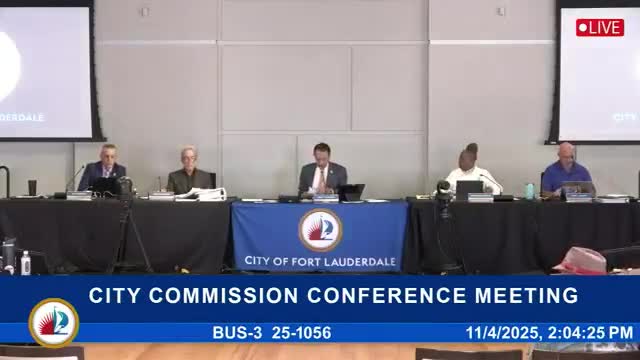Susan Grant of the city manager’s office introduced presentations by Hall of Fame partners and PFM on a revised, phased plan for the International Swimming Hall of Fame (ISHA) peninsula redevelopment.
Mario Caprini and Hall of Fame partners said phase 1 (seawall and ocean rescue building) closed in October 2024 and that the project’s new design adds an aquarium, raised promenade, shade structures and revised leasable space. Their updated summary showed total project costs of about $218 million across phases, with revised allocations that increase tenant‑improvement (TI) funding and raise the city’s proposed preferred revenue cap from $2 million to $4.75 million before profit splitting with the Hall of Fame partner.
Construction partner Hensel Phelps and others described the seawall and ocean rescue building underway and said phase 2 vertical work is progressing; the seawall and ocean rescue building completion is targeted for June (year noted in slides). The team emphasized community coordination (aquatic staff, Venetian residents, Central Beach Alliance) and enumerated proposed program elements for phases 2–4 including an aquarium, west and east buildings, parking decks and elevated promenade.
PFM Financial Advisors presented sensitivity analyses and market comparisons. Kevin Plensler said construction and tenant‑improvement costs have risen since the original 2023 pro forma and that the most material downside risk in their scenarios is reduced occupancy of leased space; PFM’s stress runs showed the city’s net position would deteriorate if lease‑based revenue and naming rights fell substantially. PFM also noted local retail lease rate assumptions aligned with market data.
Commissioners repeatedly pressed Hall of Fame partners on three issues: (1) how a smaller redesigned west building could show a substantially higher phase‑2 cost; (2) the large increase in tenant‑improvement allocations and whether landlord‑provided TI amortization shifts risk to the city; and (3) the master‑lease payment and cap increases that could raise annual city obligations (a figure cited in discussion was roughly $13.6 million as a master‑lease payment used in PFM scenarios). Hall of Fame partners and construction representatives said the overall total for all phases remained near prior totals but that phasing and the aquarium’s addition required significant redesign, more TI allocation and reallocation of costs among phases.
City staff and several commissioners said they are not willing to simply accept shifting more downside risk to the taxpayer and asked staff to negotiate additional protections or different financing arrangements and to “sharpen the pencil” on revenue sharing and TI financing. Commissioner comments included requests to explore carving TI financing out of the city obligation, to examine additional private financing structures (e.g., lenders that do not require security interests in government property), and to assess whether reducing the city’s fixed payment exposure was feasible without undoing the approved phase‑1 closing.
Two community members and ISHA/aquarium proponents—Rich Wolitzer (aquarium lead) and swimmers Mary Pellequin and Carla Albano—spoke in favor of the aquarium and the redesign, highlighting expected visitor draws, educational programs, rehabilitation and job creation and urging careful program design for aquatic users.
PFM and staff agreed to follow up with additional scenarios and the development team agreed to work with staff on options to reduce city exposure. Several commissioners said they favored keeping the design changes that reduced height and added shade and promenade elements but wanted a better balance of revenue sharing and risk before committing to revised phase approvals.
Why this matters: The project reconfigures a high‑profile, city‑owned peninsula with substantial public infrastructure, long‑term lease obligations, and a revenue structure that determines whether the city receives preferred returns or remains on the hook for lease payments; changes in occupant mix, TI funding and market performance materially affect long‑term city risk.
Next steps: Staff and Hall of Fame partners will continue negotiations, PFM will refine scenario analyses, and the commission asked staff to return with potential contract and financing changes to reduce city downside exposure while preserving the revised project design where possible.

